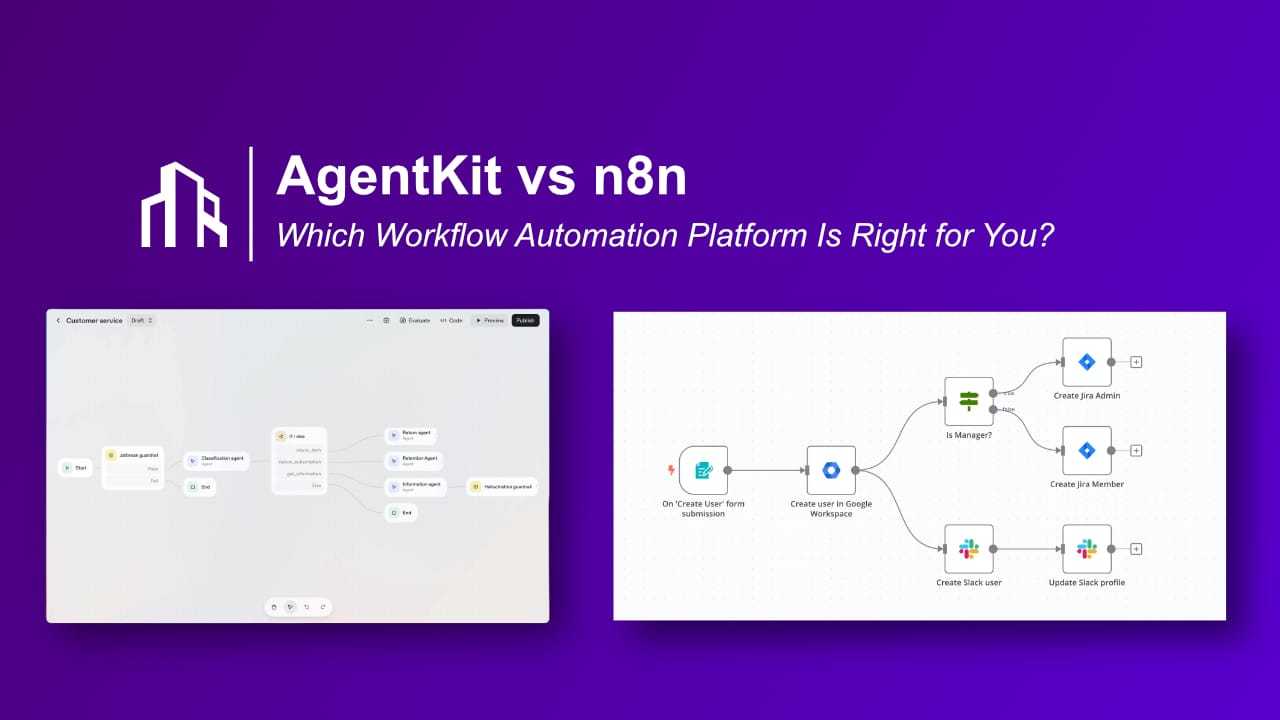AgentKit vs n8n: Which Workflow Automation Platform Is Right for You?
AgentKit and n8n both promise workflow automation, but their approach, architecture and use-cases differ significantly. Here’s what you need to know.

When choosing a workflow automation platform you want more than connectors: you need control, scale, governance and future proofing. That’s why comparing AgentKit and n8n matters.
In this article we explore how each platform works, where they excel, where they fall short and what that means for your business.
What is AgentKit?
AgentKit is a framework for building “agentic” workflows intelligent agents that orchestrate tasks, reason over context and execute across systems. It emphasises modular reasoning, memory and structured flows. It’s less about simple task automation and more about building autonomous components in your stack.
Key characteristics of AgentKit
- Workflow logic represented as nodes that mimic reasoning steps
- Modular, agent-first architecture rather than basic connectors
- Focus on memory, state and context rather than only triggers and actions
- Typically requires more architectural maturity, and perhaps more development investment
Strengths
- Good fit for organisations pursuing advanced automation (agents, reasoning, memory) rather than simple flows
- Encourages standardised, scalable agent workflows rather than ad hoc scripts
- Future-oriented: built for the “agentic automation” era
Weaknesses / considerations
- Possibly more complexity; may require higher technical maturity
- Less proven as a “mass-market workflow automation tool” compared to platforms like n8n
- Might be overkill for simple automation use-cases
What is n8n?
n8n is an open-source workflow automation platform that gives you a visual builder, code fallback, self-host option and 400+ integrations. Its sweet spot: teams that need to automate business tasks, integrate systems, and retain control without reinventing everything.
Key characteristics of n8n
- Visual node-based workflow builder (drag-and-drop) with ability to embed custom code when needed
- Strong in connectors and data flows: integrate many apps, databases, APIs
- Both cloud and self-host options; open-source background gives flexibility and transparency
- Suitable for wide variety of automation use-cases, from simple to moderately complex
Strengths
- Low barrier to entry: you can start with visual tools and scale with code
- Large ecosystem of integrations and community templates
- Good choice for broad automation across departments
- Strong value proposition for teams wanting control and extensibility
Weaknesses / considerations
- While powerful, it may not be optimized for true “agentic” workflows or complex reasoning
- Visual builder + many connectors is great but risk of brittle flows remains if governance is not enforced
- Scaling large multi-branch, highly autonomous workflows may require heavy governance
Side-by-Side Comparison
| Dimension | AgentKit | n8n |
|---|---|---|
| Primary purpose | Agentic workflows with reasoning, memory & context | General workflow automation with connectors & code |
| Technical complexity | Higher — requires design of agent logic | Medium — visual builder + optional code |
| Best suited for | Teams building autonomous agents | Teams automating business tasks and integrations |
| Integration ecosystem | Focused, may require custom connectors | 400+ integrations and large template community |
| Governance & observability | Built-in | Requires manual enforcement |
| Self-host vs cloud | Depends on implementation | Both available |
| Time-to-value | Longer (more complexity) | Shorter (faster setup) |
| Scalability for agents | High | Medium |
Which Should You Choose?
Choose AgentKit if you:
- Have mature engineering or ops teams
- Need scalable, adaptive automation
- Work in regulated or high-complexity domains
- Want to build reasoning agents with memory and state
Choose n8n if you:
- Want quick wins and fast deployment
- Need many integrations out-of-the-box
- Prefer open-source flexibility
- Plan to extend via code over time
Risks & Considerations
- Tool sprawl: Avoid mixing too many platforms. Standardise where possible
- Governance: Ensure any platform has traceability, access controls and rollback
- Long-term goals: Don’t optimise short-term if long-term flexibility or intelligence is your goal
- Cost of ownership: Include infra, reviews, engineering not just licensing
Bottom Line
n8n is practical, battle-tested and excellent for many automation use-cases.
AgentKit is strategic, forward-thinking and ideal if you’re serious about agent-based architecture. The right choice depends on your scope, skillset and growth plans.
How Can Scalevise Help?
Scalevise helps businesses turn complex digital challenges into scalable solutions. Whether you're facing compliance, automation, integration or innovation hurdles our team delivers custom strategies and implementations that work. Schedule a call with us:
